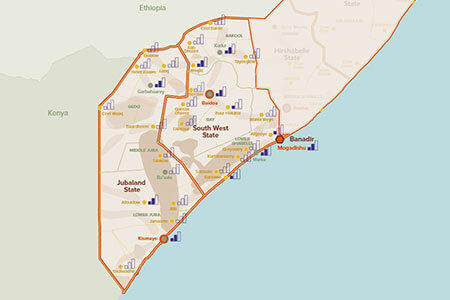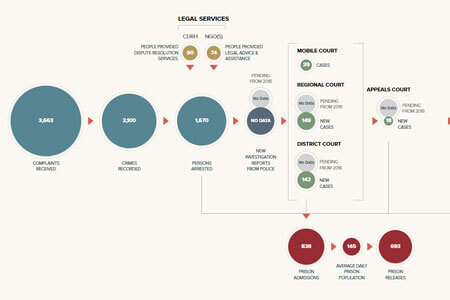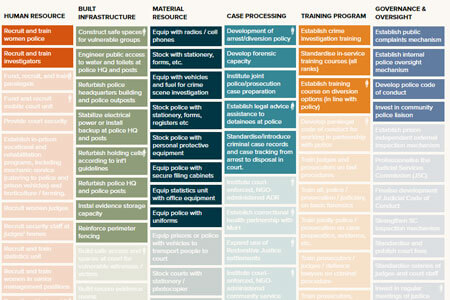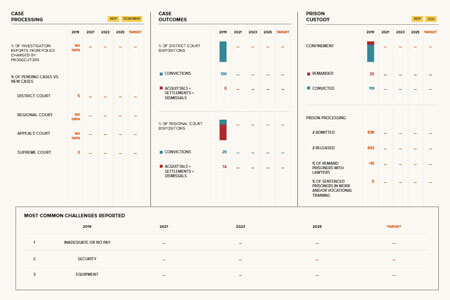Justice Snapshot South Central Somalia
JUSTICE SNAPSHOT SOUTH CENTRAL SOMALIA 2020
THE JUSTICE SNAPSHOT
The Justice Snapshot South Central Somalia captures data on the criminal justice system as it functioned in South West State, Jubaland and Banadir region (Mogadishu) in the year ending 31 December 2019.
This is a collaborative product of governments, justice actors/practitioners, court users, implementing and development partners. It applies and adapts the Justice Audit methodology used in Malaysia and Bangladesh previously (see Methodology).
From contract signing to data validation of the datasets for each state took less than 2 months. This efficiency is attributable in great part to the active support of the governments concerned and their nominated representatives in the Justice Snapshot Steering Committees (‘JSSC’ – established for each state/region) which oversee the process of data collection.
A process to improve data collection and inform policy making…
This Justice Snapshot is intended as the start of a process that sees government and justice institutions investing more in their own data. The data belong to the governments and institutions concerned. The Justice Snapshot team first obtained permission from each institution to collect and publish these data. All data presented here were formally validated by the JSSCs. The website is updateable and the intention is that an information management unit(s) will be established to capture data going forward. The visuals will automatically reconfigure to reflect the new data. The Key Measures will monitor progress and generate trend data against government policy documents, such as the NDP-9 and the current Roadmap to Security and Justice produced by the Ministry of Justice and Judicial Affairs, as well as data relevant to the Sustainable Development Goals (SDGs).
…providing an agreed set of data all can plan around
The web application is in Somali/English translations (toggle top right of each page) and is divided into a number of sections.
The Situational Overview frames the context in which statutory justice services function. Zones of Control, Internal Displacement of people, and Security and Violence against justice personnel each depict conditions which impact on these (and other) services – and the Budgets and Expenditure allocations available to them.
At the Federal Member States level, the data are organised to present a detailed account of Resources and Infrastructure, Case Management and Governance and Training, across the entire continuum of justice services in a way that reveals how pressures or gaps in one part of the system have an impact across the full spectrum of operations.
The Key Measures are drawn from policy documents and are advanced as possible benchmarks against which to monitor progress in each state (click on >Show at the top and a drop down appears for South West State, Jubaland and Banadir region). Measures of Build-Train-Equip, Governance, Case Management, and System Legitimacy start in 2019 (the year most data are gathered) and can be updated at intervals (two years are suggested here). The ‘Target’ is deliberately left open as each state will determine its own.
The Opportunity Analysis sets out a number of Justice Investment Options indicated by the data. The options are advanced for consideration and are not exhaustive. They are suggested by the data gathered and gaps they reveal. The Investment Options can be viewed in different combinations to provide menus of supporting activities (>Filter by the categories listed on the left and click on a combination of several). They might be seen as a set of ingredients to inform planners, programmers and institutional decision makers in designing a programme, plotting an intervention or embarking on a series of reforms. At the bottom on the left, by clicking >Filtered results: show detail, actions can be prioritised and their sequencing more easily clarified.
After Acknowledgements and Methodology, the Baseline Data contain all the data collected and cleaned and validated by the JSSC in excel format. The data contained in any visualization can be cross-checked here. The Library is a repository of all documentation relevant to the justice sector, including the laws (in Somali, English and Italian).
A working tool rather than stand alone report
The Justice Snapshot should be used as a tool to follow a particular line of enquiry, rather than as a report to read through section by section.
Navigating tip 1: Click, click, click
Start with a question and then follow the line of questioning. For example, the high attrition rate of Darwish in Jubaland (Situational Overview > Security and Violence > legend: > Police) may lead to a closer inspection of the Darwish in Kismayo (Federal Member States > Jubaland State > Kismayo > Resources & Infrastructure > Darwish) and examination of the state budget (Situational Overview > Security Context > Budgets & Expenditures).
Navigating tip 2: Pick a strand and see where it leads
Taking, for example, the position of a judge in Xudur (>Federal Member States > South West State > Xudur) asking what the Justice Snapshot has to say about the courts there (>Resources and Infrastructure) and seeing from the photographs what sort of challenges the judiciary confront. The same ‘Judge’ may want to go on and look at the caseload (>Case Management) and pay and grade scales, or training (> Governance & Training).
Navigating tip 3: Filter the Investment Options
The ‘Judge’ above may go on to view the Opportunity Analysis and the Justice Investment Options the data indicate. S/he will see many options, so s/he filters them. Since there is no court building in Xudur (for any court), the judge may click on
>Built Infrastructure – and filter this by
>Court.
Further filtering enables the judge to view these options from the point of view of the most marginalised and vulnerable groups by adding
>Human Rights
And so on.
Navigating tip 4: Data do not / will not always add up
None of the institutions is required to report with the degree of rigour and disaggregation set out here. In some places, there were no Registers or Ledgers, in others the administrators had no training on what or how to administer. In places, the data did not exist (for instance, cases disaggregated by gender or age); while in others it was volunteered in interview and unsubstantiated from records. The data are provided in good faith, there will be error and these errors are identified or indicated where they are apparent. Are they 100% accurate? No, but few countries can boast this. Are they the best available? Probably yes. It is worth recalling that this exercise marks the beginning of a process to improve data collection locally which will inform policy making nationally.



